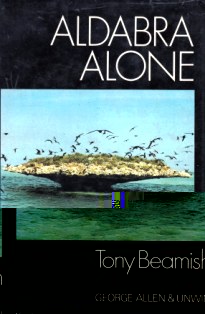Aldabra – the story of a successful conservation campaign |16 November 2012

Having seen the three-dimensional film which was released some years ago about the Galapagos Islands, I am aware of the thrilling feeling of seemingly being on the islands intermingling with the tortoises, playing with the birds and listening to bursting of the waves.
It is an unbelievable sensation and certainly a gift of great consolation to most people who will never be able to cruise around the archipelago or touch its soil.
However, I am wondering to what extent the Czech contingent who produced and is making the film is aware about the history of the islands and how, they come to have been preserved to this day as a “natural museum”.
Have they read the story of the man who pioneered eco tourism worldwide, Lars Eric Lindblad’s “Passport to Anywhere” published in 1986 by Times Books with an introduction by the then world leading ornithologist Roger Tory Peterson?
Part of the story of Aldabra as written in Lindblad’s autobiography (page 176) reads:
“The United States together with Britain was casting around for a suitable island for a strategic air and naval base in the region.
Meantime, Jimmy Mancham was pushing hard for a commercial airport, which he considered a must to put the Seychelles on the map. He was well aware of both the U.S. and British aspirations for an air base, and used this knowledge in eventually getting the commercial airport established.
“A survey team had already visited Aldabra and found that the island would be ideal for a military base, with ample room for long runways and a large lagoon that could be blasted out for the naval base.
This caused considerable concern among people interested in the natural sciences and the whole ecology of the area.
Aldabra, twenty-one miles long and nine miles wide, is the only other place in the world besides the Galapagos where the giant tortoise exists. It also features other rich wildlife, especially birds, some of which are entirely endemic to this island.
The tortoises were important symbolically, too. The coat of arms of the Seychelles features prominently as part of the islands’ heritage.
Through Mancham’s conservation efforts, it has become a protected species, a step applauded by wildlife experts throughout the world.”
Have they read the book which preceded that of Mr Lindblad, Aldabra Alone by Tony Beamish published in 1970? (I have a copy specially dedicated with the good wishes of the author in Mahé on 29th November 1970).
The book tells of the campaign to save Aldabra from the threatened construction of an air field there: of how scientists and conservationists on both sides of the Atlantic, led by the Royal Society and in the American Academy of Sciences, triumphantly fought up for the atoll that few people had heard of before. He made a power plea for the preservation of a scientific wonder that will remain in danger unless plans to have an airfield there were finally be scraped.
Yes, we did finally succeed to save Aldabra and it is then that the British and Americans decided to move to the Chagos archipelago where they established the Diego Garcia base.
I am proud to having been part of the local campaign to save and preserve Aldabra. But I was not alone.
I enjoyed the support and encouragement of the then Governor of Seychelles Lord Oxford and Asquith and such local personalities like Harry Savy who was the lessee of Aldabra, the late Esme Jumeau, the late Guy Lionnet, the late Philippe Loustau-Lalanne ,the late Kantilal Shah and the late Tony Bentley-Buckle.
The international campaign was spearheaded by Tony Beamish with the support of his cousin Sir Tufton Beamish a conservative MP and such famous names like Lars Erik Linblad, Roger Tory Peterson, David Stoddart and Sir Julien Huxley who stated in the foreword of the book.
“As a natural treasure house, Aldabra must belong to the whole world.
To sacrifice such a legacy for temporary strategic gain would be an act of vandalism.
I hope that Tony Beamish’s book will bring the issues at stake to the widest attention and help to prevent such threats from arising again, and if they do come, to provide some indication of how they may be met.
Aldabra Alone is an exciting story of exploration and of a dramatically successful conservation campaign. It is both a reassurance and a challenge.”
James R. Mancham




